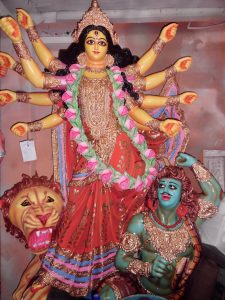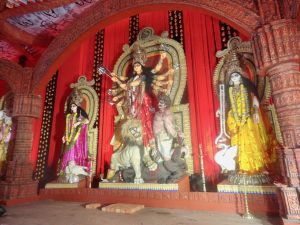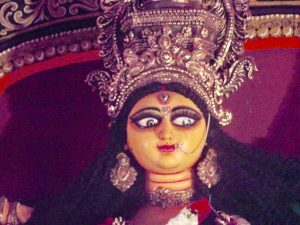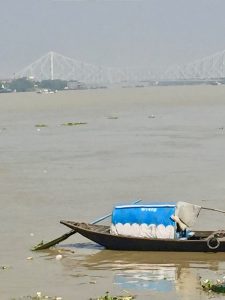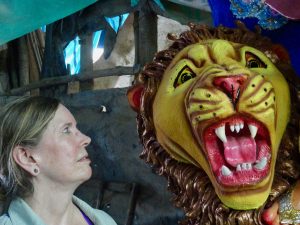Durga Puja occurs in every autumn, immediately before Diwali, and is the largest festival in Calcutta. This year’s festival dates were October 7 through 11. Happily I was in the city a week before the event, and so was able to see the final stages of preparation.
Durga Puja is celebrated throughout India, but Calcutta has the largest event by far, because Goddess Durga takes special care of Bengal. People began arriving in the city while I was there, finding shelter wherever they could.
According to legend, Durga makes an annual visit to Calcutta from her home in the Himalayas where she lives with her consort Lord Shiva and their children. Of course other legends stress Durga as as the embodiment of shakti, the divine feminine energy that exists in a state of complete self-sufficiency. Either way, she is the means by which good triumphed over evil when she slew the demon Mahisa. [Here’s the story.]
Preparations for Durga Puja begin months in advance in Calcutta’s Kumartuli neighborhood, the traditional street of potters. When complete, Durga will take center stage. Durga’s lion stalks on her right, his golden mane a contrast with her red sari. On Durga’s left, the defeated demon. In her ten arms, Durga holds the weapons she used in her struggle.
The tableau includes Durga’s four children: Lakshmi (Prosperity) and Saraswati (Wisdom) on her right; Kartikeya (War), and Ganesha (Success) on her left. A small figure of Lord Shiva is painted above Durga’s head. Ganesha’s two wives are also present, represented by banana stalks.
Creating the images in their tableau is a lengthy and ritualistic process. The figures are made on a bamboo frame covered with straw and held together with jute string. Clay from the nearest river, preferably the Ganges (as is the case in Calcutta) is applied in three layers. The last layer is paster of Paris.
The figure can then be painted. The eyes are painted last. The images are varnished. Hair made from jute is glued as needed. Finally, the image is dressed and decorated with dazzling colors and ornaments.
It can take up four months to complete a single image, and the artisans of Kumartuli create hundreds commissioned by neighborhoods, private families and businesses.
The sponsors also build Pandals in which to house the images. These temporary temples are enormous structures built on bamboo poles and covered with fabric. Competitions are held between neighborhoods for the best pandals and puja themes. ‘Pandal-hopping’ is a popular pastime during the festival.
Durga Puja caught on as a popular festival in the 18th century. In 1857 Raja Nabakrishna Deb held a puja at his home in honor of Robert Clive’s victory over the French at the Battle of Plassey. The victory established British East India Company rule in Bengal.
Subsequently, other prominent Bengali families held pujas at which Company officers were guests of honor. Each family tried to outdo the others in the presentation of food, decoration, music and entertainments.
Less elite families originated community pujas. Twelve friends in West Bengal collaborated to collect contributions for local residents to hold the first community puja in 1790. The practice came to Calcutta in 1832. In 1910 larger community pujas took place as public celebrations. Over the years both the images and the pandals have become larger and more decorative.
On the last day of the Durga Puja, the idols are taken to the nearest body of water and immersed head first. Crowds come to bid Durga farewell as she returns to the Himalayas and then join their families and friends.
When the images were made with natural clay and vegetable dyes, the materials naturally dissolved into the water. When Durga Puja was a community event in which 2,000 people might produce one set of images, the number of idols immersed in the river was relatively small.
Today, worshippers take hundreds of images to the water. Most of these contain non-biodegradable materials which are also toxic. Plaster of Paris and paints containing mercury, cadmium, lead, and carbon create beautiful images, but they lower oxygen levels in the water.
To reduce pollutants, the City of Calcutta positions barges near the river banks in order to lift out the idols immediately after immersion.
Next year Durga Puja will be September 26-30.
???
Once again, my gratitude to Chefs Mauhkh and Harmeet at the Oberoi Grand who prepared food for me that was gluten free.
Photos by Author.
“The Durga Puja Festival of Kolkata and West Bengal.” From Lost to Found Travel.
“What is so Special About Durga Puja in Bengal.” Indian Today Education. Oct. 16, 2015,
Anastasia Basu. “Where Durga Rides a White Lion.” The Telegraph Calcutta. 4 Oct. 2016. P. 19.
Soma Basu. “Idol Immersions after Durga Puja.” DownTo Earth. Oct 18, 2013.
Rama Chowdhury. 20 Photos of Durga Idol Making.
Sharell Cook. “When is Durga Puja?” About Travel.
Das, Subhamoy. “History and Origin of Durga Puja.” About Religion. Feb 28, 2016.

Sandra Wagner-Wright holds the doctoral degree in history and taught women’s and global history at the University of Hawai`i. Sandra travels for her research, most recently to Salem, Massachusetts, the setting of her new Salem Stories series. She also enjoys traveling for new experiences. Recent trips include Antarctica and a river cruise on the Rhine from Amsterdam to Basel.
Sandra particularly likes writing about strong women who make a difference. She lives in Hilo, Hawai`i with her family and writes a blog relating to history, travel, and the idiosyncrasies of life.

